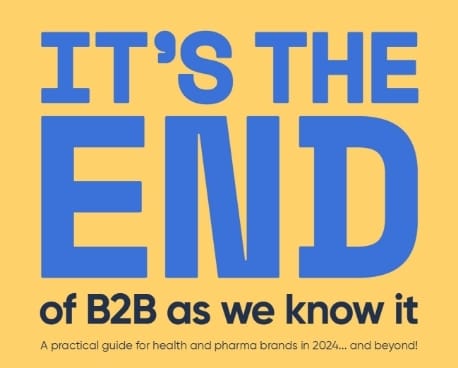The evolution of consumer health: insights, challenges and the importance of marketing
The consumer health industry has recently experienced a huge transformation, with patients across the globe taking more interest in managing their own health than ever before.
In fact, one in 20 Google searches is now said to be related to a healthcare-related question or problem.
Whether it be the food supplement, beauty or tech space, the evolution of consumer health brands has been propelled by three key things: changing consumer attitudes, increased access to information and the industry’s response to global health challenges like COVID-19.
This has led to several changes across the healthcare landscape, especially in terms of how consumer health brands should embrace the growing willingness of consumers to manage their own health.
Deloitte’s Future of Diagnostics report, for example, found that direct-to-consumer (DTC) testing had ‘increased five-fold from the start of the pandemic’, with clinicians across Europe seeing patients more and more engaged with their own health and wellbeing.
So, how can brands in the consumer health sector embrace this growing movement? And what role can marketing play in ensuring success moving forward?
Firstly, what is the consumer health sector?
”The consumer-health industry is booming, driven by an ageing population, a proliferation of wellness-related products and services, burgeoning sources of health-related information and consumers’ desire to control their health.“ – McKinsey
The consumer health sector refers to products, services, and information intended for use by individuals to maintain and improve their personal health and well-being, outside of medical settings.
Consumer health solutions are separate from prescription-only medicines and class II-III medical devices, which are typically only available under the care and guidance of a licensed physician.
Whether it be picking up an over-the-counter medicine at the supermarket or browsing for skincare online, consumer health products are usually used by people trying to manage their health themselves – either as a proactive approach to maintain their health or a more reactive way to deal with a minor illness.
As such, the consumer health industry is now made up of a diverse range of easily accessible healthcare products, including:
- Over-the-counter (OTC) medicines – non-prescription medications like pain relief, antacids, antihistamines and cold remedies.
- Dietary supplements and vitamins – vitamins, minerals, nutritional supplements, herbal teas and fibre drinks that support the diet and overall health of patients.
- Personal care products – oral care, skincare, hair care and period care products.
- Class I medical devices – blood pressure monitors, thermometers, orthotics and various other digital health tools like sleep trackers, smartwatches, heart rate monitors and pedometers.
- Diagnostic products – pregnancy tests and various home testing kits for cholesterol, iron levels and more.
- First aid supplies – bandages, antiseptics, plasters and wound care-related products.
- Alternative remedies – natural products, often made using plants and natural ingredients, for example sleeping aids, homoeopathic medicines and essential oils.
- Sports-related products – energy drinks, protein supplements and muscle creams.
The combination of having huge accessibility and such a wide product range has also set consumer health apart in recent years, with the sector estimated to be worth a staggering $500 billion – a number expected to double by 2027!
Each individual type of consumer health product has seen its own growth in recent years as well. Within the global digital health market, for example, over 40% of adults now have access to a device capable of measuring at least one health parameter.
But you don’t need to look back too far to see why these numbers are the way they are.
Thanks to factors like the COVID-19 pandemic, an ageing population and an increasingly stretched NHS reducing access to various health resources, consumers have been actively encouraged to use alternative healthcare channels, fueling a surge in demand.
As such, many healthcare brands are now looking to use this growing popularity to their advantage. How, you ask? Four words: an effective marketing strategy.
The importance of marketing in consumer health
Unlike prescription-only medications, consumer health products are within easy reach, allowing people to self-treat and access healthcare on their own terms. From a marketing perspective, this accessibility allows innovative D2C strategies to be tailored towards consumer attitudes and behaviour.
While this may sound simple, you need to make sure you’re not just recognising the importance of marketing. Instead, you need to delve into the actionable consumer insights that will actually deliver success.
In other words, don’t just create content for the sake of it. Start by considering the consumer journey and then create relatable content that uses these insights.
Here are some of the key things you’ll need to think about:
- Get to know your audience – start by looking at who your audience is, and keep up-to-date with their ever-changing preferences, challenges and aspirations. What resonates? And what doesn’t?
- Speak their language – communicate in a way that connects, avoiding jargon and tailoring your content in a way that consumers can understand and relate to.
- Use their preferred channels – whether it be via social media or a search engine, identify the channels your audience uses and meet them where they are.
- Put yourself in their shoes – remember that you’re not just trying to sell a product, you’re trying to change how consumers perceive it. So think about their perspectives and address the aspects that matter most to them.
- Create a seamless journey – recognise the interplay between online engagement and offline purchases, by crafting a journey that guides consumers from digital touchpoints to in-store experiences.
- Consider retargeting – use a data-driven retargeting strategy to reconnect with potential consumers, showing them why your products offer a solution, not a choice.
As we’ve already highlighted, the consumer health industry is booming and isn’t going to slow down any time soon. Want our advice? Craft marketing strategies that don’t just inform but also inspire, build trust and foster brand loyalty.
Sticking to the rules
However, it’s not just brand loyalty you need to think about within your marketing strategy.
While the consumer health sector may not seem as tightly regulated as the pharma space in terms of what you can say and to whom, it remains closely governed by regulations, codes and standards of best practice, set by organisations including:
- Proprietary Association of Great Britain (PAGB) – the UK trade consumer healthcare association.
- Advertising Standards Authority (ASA) – the UK’s regulator of advertising.
- Medicines and Healthcare products Regulatory Agency (MHRA) – a regulatory body that all consumer health products must adhere to.
Not considering these when creating marketing strategies could lead to severe repercussions, making it incredibly important to consider any associated regulations and guidelines.
Working with PAGB’s Code of Practice
The PAGB, for example, represents 90% of the top 50 consumer healthcare brands that manufacture branded OTC medicines, self-care medical devices and nutritional supplements within the UK.
While their Code of Practice guidelines may be strict, sticking to them lays the pathway to success in various ways:
- Trust and reputation – by aligning with the PAGB’s standards, you signal your dedication to ensuring transparency and ethics in your marketing, while prioritising consumer trust.
- Legal assurance – sticking to the PAGB’s guidelines not only ensures your marketing is accurate but is also protected against any potential legal complications.
- Badge of honour – being part of the PAGB family is more than just a label. It proves you’re committed to maintaining the integrity of the industry.
- Ongoing improvement opportunities – addressing any concerns or legal mistakes can help pave the way for improvement, allowing you to learn how to uphold industry standards in the right way.
- Regulatory body collaboration – working hand-in-hand with the ASA, aligning with PAGB regulations will help position your brand as a positive contributor to the industry.
- Brand resilience – with consumers becoming increasingly aware of the integrity of the brands they choose, adhering to PAGB guidelines can give you a competitive edge and position your brand as their preferred choice.
Preparing for the future
The consumer health sector’s ongoing evolution may be seen as a good thing to many but, as with any type of evolution, it’s important to be prepared for any potential future challenges.
While patients may feel more empowered than they have done before, for example, there is still a long way to go. In fact, a recent NHS survey found that many consumers still lack the confidence, tools and technologies to take control of their health in the way they would like.
As such, it’s important to prioritise patients within your strategy, by making sure your content is accessible to people with a range of backgrounds, including lower levels of education, health literacy and those with visual, cognitive or communication challenges.
When developing any health information, it can be useful to use this simple mnemonic – EASIER – used by the team at Medico – to check your content is:
E – Engaging: Is this content in a format that is interesting and digestible for patients? Can information be presented in a format other than written prose, such as infographics, images or videos?
A – Accessible: Does your content meet best practice in terms of design (visual contrast, text size, compatibility with assistive technology) and is it written in plain language without long words, complex sentences or technical vocabulary? (Guidance suggests aiming for a reading age of 9-11 years)
S – Shareable: Can patients easily use this information in discussions with their pharmacist, store assistant or doctor? Can they send it to friends and family to get a different perspective?
I – Informative: Does the content clearly outline the key points, without excessive detail? Is the content based on quality, ideally peer-reviewed sources and verifiable information?
E – Empowering: Does the content help the individual understand their condition in a way that’s meaningful for them? Does it help equip them with knowledge and skills to help self-manage their condition, or get the help they need?
R – Relatable: Does this actively address real patient challenges? Is it rooted in their ‘real life’ experience? Does it speak to their concerns, priorities and needs?
It’s also important to consider how patients access healthcare-related information.
According to NHS England, for example, the role of the pharmacist has steadily increased in recent years, with pharmacies seeing over 100,000 patients in June last year – an 83% increase on the year before. So why not harness this movement?
We have already seen brands doing just that, establishing great relationships with online pharmacies to increase product awareness and their overall number of conversions.
Medico Digital: a trusted consumer health expert
At Medico Digital, we are specialists in creating engaging patient materials and campaigns, and have proven experience across the consumer health space, including household brands such as Rennie, Canesten and Berocca as part of our partnership with Bayer.
Our team of digital experts ensure that regulatory and compliance requirements are not just met, but exceeded in every consumer health marketing campaign we create. We’re also waiting with bated breath for a new accreditation by the Patient Information Forum under their PIF Tick scheme – the UK’s independently assessed quality mark for trusted health information.
To see us in action, take a look at some of our case studies.
Alternatively, find out more about how to navigate the ever-changing consumer health market by simply getting in touch! We’d be more than happy to help.
Sources
- https://www.reportlinker.com/p06282419/Consumer-Healthcare-Global-Market-Report.html?utm_source=GNW
- https://www.nhsconfed.org/system/files/2023-06/Patient-empowerment-role-technology-transforming-care-FNL.pdf
- https://www.gsk.com/media/8219/emma-walmsley-investor-event-transcript.pdf
- https://www2.deloitte.com/uk/en/pages/life-sciences-and-healthcare/articles/future-of-diagnostics.html
- https://blogs.deloitte.co.uk/health/2022/09/unlocking-the-power-of-consumer-health-data.html
- https://blogs.deloitte.co.uk/health/2023/06/consumer-health-exploring-market-opportunities-and-challenges.html
- https://www.pagb.co.uk/about-us/about-our-industry/
- https://www.mckinsey.com/industries/consumer-packaged-goods/how-we-help-clients/consumer-health
- https://pifonline.org.uk/pif-tick/
- https://pifonline.org.uk/news/target-reading-age-health-information/
- https://library.nhs.uk/wp-content/uploads/sites/4/2023/06/Health-Literacy-Toolkit.pdf






